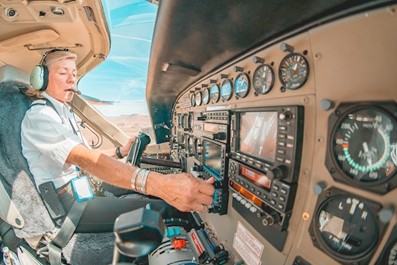William Boos of Direct Airway works as an aviation specialist and air traffic controller. In the following article, William Boos explains how air traffic controllers manage the skies, monitor flight paths, and secure successful travel plans for aircraft pilots.
As aviation remains an indispensable cornerstone of our interconnected world, the responsibilities shouldered by air traffic controllers extend far beyond mere traffic management. Their role is to not only observe, but to orchestrate the dance of aircraft across the skies. William Boos explains that it’s like an intricate choreography that ensures safe distances are maintained, collisions are avoided, and efficient routes are navigated, all while adapting to the dynamic nature of weather patterns and unexpected events.
However, the responsibility isn't solely the work of air traffic controllers. At the helm of each aircraft are the skilled and dedicated pilots, acting as the aviators who translate the instructions and guidance provided by controllers into tangible actions. Their training, experience, and clear communication with controllers are pivotal in maintaining the harmony of the skies. This delicate partnership between air traffic controllers and pilots forms the backbone of safe and successful air travel, each relying on the other's expertise to ensure the seamless operation of flights.
William Boos Aviation Discusses a Pilot’s Path
Dreams of flight are born on the ground but realized in the sky.
Indeed, being a pilot or having a career in aviation is an aspiration for many. There’s nothing like the thrill of commanding the skies and seeing the world from a different vantage point.
William Boos of Direct Airway says that on top of the many exhilarating pursuits in their career, it’s no surprise that pilots also make good money. Pilot salaries in the United States exhibit a wide spectrum, reflective of factors ranging from experience and aircraft type to the airlines they are associated with.
Entry-level pilots, often designated as "first officers" or "co-pilots," typically start at lower pay rates compared to their more experienced counterparts. This initial compensation, while modest, serves as a steppingstone for young aviators to gain the flight hours and expertise necessary for advancement.
William Boos explains that as pilots accrue flight hours and experience, their pay rates rise steadily. Many airlines have progressive pay scales, which reward pilots for each year of service or a predefined number of flight hours. For instance, the jump from a first officer to a captain position comes with a notable increase in pay, often accompanied by enhanced responsibilities. A captain's role involves not only operating the aircraft but also making command decisions and leading the cockpit crew.
Requirements for Working in Aviation
William Boos of Direct Airway says that anyone interested in working in aviation must attend flight school and receive pilot training at any institution approved by the
Federal Aviation Administration. A bachelor’s degree in aviation (or a related field) is the first requirement that most major airlines look for during the application process.
Earn a Pilot’s License
After graduating from flight school, the next step is to obtain a pilot’s license or a private pilot’s certificate. This requires learning basic flight methods, aircraft maneuvers, flight planning, navigation, and emergency training. Once certified, the pilot will be allowed to fly a plane on their own.
 Obtain Other Important Certificates and Ratings
Obtain Other Important Certificates and Ratings
William Boos, aviation specialist explains that part of becoming an airline pilot is logging plenty of hours in the air. The FAA requires a minimum of 1,500 flight hours which can be done through classes, training, flight instruction, and working as a commercial pilot.
- Instrument Rating (IR): Once a basic pilot certificate is earned, the next thing to acquire is an Instrument Rating, one of the most valuable ratings one can add to their pilot license. This certification teaches pilots to fly solely in reference to instruments. It also teaches them how to interact with the National Airspace System and traffic control.
- Commercial Pilot License: This license allows pilots to take jobs on corporate or tourism passenger flights, search and rescue, and cargo deliveries. Pilots can opt to take additional training to earn ratings for each type of aircraft they want to fly.
- Flight Instructor Certificate: Working as a flight instructor is one of the quickest ways to gain experience and log the hours needed to become an airline pilot.
- Airline Transport Certification (ATP): An ATP is the highest license that the FAA issues. To acquire this certification, pilots must log in hours as a Pilot in Command (PIC), cross country PIC, and of nighttime flying on top of the required 1,500 flight hours.
Complementary Aviation Roles
William Boos notes that the role of air traffic controllers extends beyond mere technical coordination; it embodies a dedication to passenger well-being and the protection of lives in transit. Their capacity to remain composed in the face of turbulence, unexpected deviations, and emergencies underscores their indispensable contribution to aviation's intricate fabric.
Pilots, with their years of training, keen situational awareness, and swift decision-making, serve as the wings that turn air traffic control directives into graceful ascents and descents. Their mastery of flight instrumentation, communication protocols, and emergency procedures paints a vivid picture of their dedication to the art of flying.
So, the next time you gaze upon the skies and see an airplane soaring gracefully overhead, remember that it's not just the pilot's hands on the controls but a collaborative spirit that spans both the skies and the ground. The art of aviation, as embodied by air traffic controllers and pilots, is a testament to human perseverance, expertise, and cooperation.
Together, they ensure that the boundless expanse above remains not just a domain of flight, but a sanctuary of trust and mastery that brings us closer to the heavens while keeping us firmly grounded in safety.
 Obtain Other Important Certificates and Ratings
Obtain Other Important Certificates and Ratings